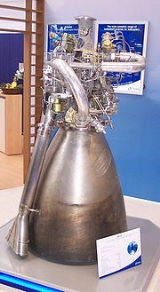
HM7B
Encyclopedia
The HM7B is a European
cryogenic rocket engine
which currently powers the upper stage of the Ariane 5 ECA, ESC-A.
. The evolved HM7B, with higher specific impulse
, powered the third stages of Ariane 2
, 3 and 4
. It was first used in the Ariane 5 in 2002, when the first ECA version of the launcher flew, although the launch failed before first stage separation, so the first time an HM7B actually powered the upper stage of an Ariane 5 was in 2005. The switch to a cryogenic engine is responsible of more than half of the overall payload increase of the Ariane 5 ECA versus its previous version, the Ariane 5G. The HM 7, HM7B Engine family has 5 failures during its use in Ariane 1 - 4 rockets. Flight V 70 was the last failure of an HM7B.
rocket engine fed with liquid oxygen
and liquid hydrogen
. It has no restart capability: the engine is continuously fired for 950 seconds in its Ariane 5 version (780 s in the Ariane 4). It provides 62.7 kN of thrust with a specific impulse of 444.2 s. The engine's chamber pressure is 3.5 MPa.
European Space Agency
The European Space Agency , established in 1975, is an intergovernmental organisation dedicated to the exploration of space, currently with 18 member states...
cryogenic rocket engine
Rocket engine
A rocket engine, or simply "rocket", is a jet engineRocket Propulsion Elements; 7th edition- chapter 1 that uses only propellant mass for forming its high speed propulsive jet. Rocket engines are reaction engines and obtain thrust in accordance with Newton's third law...
which currently powers the upper stage of the Ariane 5 ECA, ESC-A.
History
The HM7 engine, built upon the development work of HM4, first flew in 1979, powering the third stage of the Ariane 1Ariane 1
Ariane 1 is the first version of the Ariane launcher family. Ariane 1 was designed primarily to put two telecommunications satellites at a time into orbit, thus reducing costs. As the size of the satellites grew Ariane 1 gave way to the more powerful Ariane 2 and Ariane 3 launchers.- Vehicle...
. The evolved HM7B, with higher specific impulse
Specific impulse
Specific impulse is a way to describe the efficiency of rocket and jet engines. It represents the derivative of the impulse with respect to amount of propellant used, i.e., the thrust divided by the amount of propellant used per unit time. If the "amount" of propellant is given in terms of mass ,...
, powered the third stages of Ariane 2
Ariane 2
Ariane 2 was a European expendable carrier rocket, which was used for six launches between 1986 and 1989. It was a member of the Ariane family of rockets, and was produced by Aérospatiale in France....
, 3 and 4
Ariane 4
Ariane 4 was an expendable launch system, designed by the Centre National d'Etudes Spatiales and manufactured and marketed by its subsidiary Arianespace. Ariane 4 was justly known as the ‘workhorse’ of the Ariane family. Since its first flight on 15 June 1988 until the last, on 15 February 2003, it...
. It was first used in the Ariane 5 in 2002, when the first ECA version of the launcher flew, although the launch failed before first stage separation, so the first time an HM7B actually powered the upper stage of an Ariane 5 was in 2005. The switch to a cryogenic engine is responsible of more than half of the overall payload increase of the Ariane 5 ECA versus its previous version, the Ariane 5G. The HM 7, HM7B Engine family has 5 failures during its use in Ariane 1 - 4 rockets. Flight V 70 was the last failure of an HM7B.
Overview
The HM7B is a gas generatorGas generator
A gas generator usually refers to a device, often similar to a solid rocket or a liquid rocket that burns to produce large volumes of relatively cool gas, instead of maximizing the temperature and specific impulse. The low temperature allows the gas to be put to use more easily in many...
rocket engine fed with liquid oxygen
Liquid oxygen
Liquid oxygen — abbreviated LOx, LOX or Lox in the aerospace, submarine and gas industries — is one of the physical forms of elemental oxygen.-Physical properties:...
and liquid hydrogen
Liquid hydrogen
Liquid hydrogen is the liquid state of the element hydrogen. Hydrogen is found naturally in the molecular H2 form.To exist as a liquid, H2 must be pressurized above and cooled below hydrogen's Critical point. However, for hydrogen to be in a full liquid state without boiling off, it needs to be...
. It has no restart capability: the engine is continuously fired for 950 seconds in its Ariane 5 version (780 s in the Ariane 4). It provides 62.7 kN of thrust with a specific impulse of 444.2 s. The engine's chamber pressure is 3.5 MPa.

